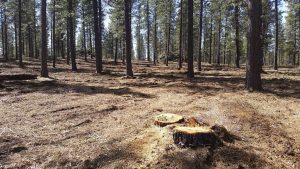
A forest stand on the Deschutes NF which has been ecologically damaged by logging. Note the absence of tree age diversity, lack of dead wood and snags, and any shrub layer. This is what the Forest Service and Deschutes Collaborative calls a “healthy” forest. Ecologically speaking this is a human-caused disaster. Photo: George Wuerthner.
A researcher in California is collecting seeds of sugar pine that appear to have resistant to bark beetles. Her goal is to capture and propagate trees that can withstand beetle attacks. According to the article, past logging of sugar pine has dramatically reduced the genetic diversity of the sugar pine population.
Loss of genetic diversity is one consequence of the Industrial Forestry Paradigm that dominates the timber industry and all public agencies from the state forestry agencies to the federal agencies like the Forest Service.
For example, on a recent field trip, the foresters in the group told us they were going to log some fir trees that had “root rot” as well as adjacent fir trees that “might” get the pathogen. No one in our group, which included several so-called “conservation groups”, questioned the starting assumption that it was desirable to eliminate root rot. When I asked the lead forester, why he felt it was necessary to log the trees, he responded by saying the trees were likely to die.
So I inquired further. “So, you want to kill the trees by logging, so they don’t die from root rot?” And then I went on and said: “Isn’t that kind of like our policy in Vietnam where we had to destroy the country to make sure the Communists didn’t destroy it?”
I followed up with “what is the ecological role of root rot in the forest ecosystem?” I got no response, just blank stares. No one had even considered that root rot might play any critical role in forests.
I do not know the role of root rot either, but I don’t just assume that removing trees with root rot “improves” the forest ecosystem. At the very least the dead trees would continue to store carbon, provide homes to countless forest animals and plants, and serve as functional components of the forest landscape.
The irony is that most of the current logging projects on public lands are justified in the name of “forest health” and “resilience.” Yet logging past and present is removing the genetically resistant trees from the forest.
One study reported in Conservation Biology sampled the genetic diversity of forest plots before thinning. Immediately after the logging project, the genetic diversity of trees in the plots was reexamined. The researchers found that approximately half of the natural genetic diversity had been removed by logging.
Importantly it was the rare genetic alleles that were eliminated. Maybe one tree in a hundred might have genetic resistant to say drought. Still, when you remove 50% of the trees from a stand, you are likely to eliminate that one tree that might provide survivors to repopulate the forest stand under adverse conditions.
One of the problems I’ve experienced in my limited participation in forest collaboratives is that no one is even asking the question of whether logging the forest harms it. The entire starting assumption is that logging creates “resilience” in our forest stands. Yet clearly, most foresters don’t even have the curiosity to ask about the genetic implications of logging, much less the answers. And sadly, most of the so-called conservation groups that participate in these collaboratives are equally as unprepared to examine the starting assumptions.
Many ecologists adhere to the “precautionary principle,” which acknowledges our collective ignorance about how ecological systems work. The precautionary principle warns us to save all the parts, restrict our manipulations to as small an area as possible, and at the same time, create extensive conservation reserves where human intervention is minimal.
Nearly all forest collaboratives I’ve examined start out with the assumption that our forests are “unhealthy” due to normal ecological processes from bark beetles to wildfire. Then, like the old-time Snake Oil Salesman, they assume they have the one and universal cure for every malady real or imagined—logging.
A red flag goes up whenever I read or hear the Forest Service claiming that they are going to thin or log the forest to improve “forest health.” Abundant evidence exists to suggest that periodic mortality—even significant losses—from drought, disease, beetles, fire, and other evolutionary processes create “resilience” and “healthy forests.”
It’s time for our public agencies to acknowledge that the Industrial Forestry Paradigm is a threat to our forest ecosystems and to act with humility in the face of our collective ignorance.